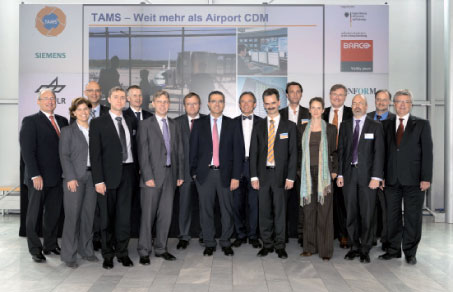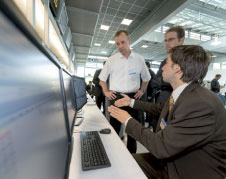
The TAMS trial was undertaken by Siemens and Stuttgart Airport, in partnership with Barco Orthogon, Inform, ATRiCS, and the German Aerospace Center (DLR).
The trial was undertaken by Siemens and Stuttgart Airport, in partnership with Barco Orthogon, Inform, ATRiCS, and the German Aerospace Center (DLR). The goal was to integrate various subsystems into one airport control centre on the basis of a holistic operational concept and to make airports more competitive and attractive without the need for costly infrastructure development.
As explained by Meier, the trial proved the benefits of implementing TAMS in three key areas: economic benefits in terms of cost savings; an improved level of service for all airport customers; and environmental benefits.
“By having a plan in place between all stakeholders, it enables you to optimise the process and optimise resources,” Meier said. TAMS allows the airport to monitor and manage passenger streams in order to match capacity with demand, he said, while the workflow management aspect guarantees that all operational decisions are made in the correct order.
“TAMS also helps to increase passenger satisfaction. In the trial it was proved that it improves the punctuality of a flight. It significantly reduced the number of passengers who missed their connecting flight and the mean punctuality of all flights was improved by two minutes,” he added. “During the trial, the taxi time of each aircraft was reduced by 30 seconds, so when you put all of the aircraft together, that’s a lot of fuel saved in total.”
Collaboration is key

Meier: “It’s very important for everyone involved to work together because an airport is just one node in the air transport system and all stakeholders need to contribute to ensure that this node operates very well.”
Key to the Total Airport Management Suite is the establishment of a single Airport Operations Control Centre as a platform for the various air and landside airport sub-processes. Virtualisation technologies are used to display the relevant information required by airport operators, air traffic controllers, airlines, ground handling companies or security forces, and this information is used to generate forecasts, provide optimisation suggestions and support each of the key stakeholders. As well as PCs and videowalls, employees can also use smartphones and other similar devices to obtain real-time information on a variety of airport operations.
Meier continued: “It’s very important for everyone involved to work together because an airport is just one node in the air transport system and all stakeholders need to contribute to ensure that this node operates very well. With TAMS, all of the stakeholders are working together on the actual strategy, rather than just sharing information.”
Having proved the viability of the modular Total Airport Management Suite at Stuttgart Airport, Meier explained that further trials will be the natural next step before a major airport decides to become the first to implement the suite on a permanent basis. “We definitely feel that TAMS should be rolled out elsewhere,” Meier added, “and we’re already having discussions with one or two significant airports.”







